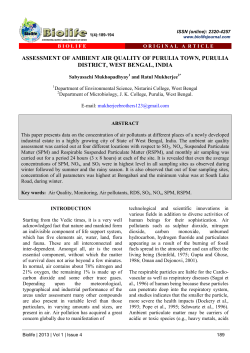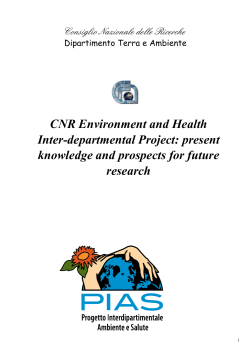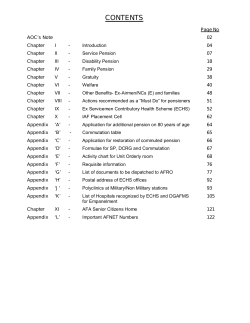
AIR POLLUTION: CAUSES & CONTROL BY DR. MUHAMMAD ANWAR BAIG
AIR POLLUTION: CAUSES & CONTROL BY DR. MUHAMMAD ANWAR BAIG VICE PRINCIPAL IESE, NUST, RAWALPINDI CANTT. The Atmosphere • Performs several important functions. Protects us from; – sun’s UV rays, x-rays, lethal amounts of cosmic rays • Without this life will cease to exist. • The interaction between the earth and sun is responsible for earth’s climate and weather. How climate is caused? • Heating and cooling of the air • Horizontal movements of the air due to earth’s rotation • Distance from the sun • The passage that sun’s energy has to pass to reach the earth’s surface Green House Effect Forest Decline Acid Rain Atmospheric Trace Gases Global Warming Ozone Hole Photochemical Smog What is air pollution? Defined as the presence of chemicals in the atmosphere in quantities and duration that are harmful to human health and the environment Types of air pollutants • Primary pollutants - products of natural events (like fires and volcanic eruptions) and human activities added directly to the air • Secondary pollutants - formed by interaction of primary pollutants with each other or with normal components of the air The air pollution problem • Air pollutants are likely to stay near the earth due to gravity • air pollutants accumulate as an air mass moves across the region • Air pollution is not just an aesthetic problem but it is also a health problem • Death occurs in the elderly and the very young Classes of air pollutants Carbon oxides -- carbon monoxide (CO), carbon dioxide (CO2) • --CO responsible for half the fatal poisonings in the US each year • --The result of incomplete combustion of fossil fuels or other organic matter. Major source of CO -- transportation. • --CO mimics oxygen and can bind to the hemoglobin in blood and prevent it from carrying oxygen Carbon Oxides (CO, CO2) cont.. • Fuel efficiency reduced ```CO – Cigarette smoking releases CO – Exposure to air containing 0.001% of CO for several hours can cause death – Can cause headache, drowsiness, and blurred vision – Natural processes can convert CO to other harmless gases like CO2 • Carbon dioxide contribute to Global Warming Hydrocarbons (HC) • Internal combustion engine, fuel suppliers, refineries, and other industries release HC. • Cause oily film after the rain, some injure respiratory tract, others cause cancer • Methane contribute to global warming, others contribute to Photochemical smog • Modifications to automobile engines have reduced HC. – Recycling some gases, using higher oxygen conc., better fuel air mixture, use of valves to prevent escape of gases, catalytic converters Sulfur oxides -- sulfur dioxide (SO2), sulfur trioxide (SO3) • Produced when sulfur in fossil fuels is released by burning • When inhaled corrodes the lung tissue - An irritant to respiratory tissue • React with water to form acid. • Can attach to particles and form sulfur containing acids.. Nitrogen oxides -- nitric oxide (NO), nitrogen dioxide (NO2), and nitrous oxide (N2O) • Transportation and stationary sources such as power plants • Cause respiratory distress • Combine with other air pollutants to form smog • A source of acid rain Suspended particulate matter • -- solid particles (dust, asbestos, soil) and liquid particles (sulfuric acid, PCBs, other pesticides) • Anything small enough to be carried by the wind • In US, particulate air pollution contributes to deaths of 60,000/yr • Volatile organic compounds -- large group of compounds ranging from coolants in air conditioners, methane, benzene Type of air pollutants • Primary pollutant -- a chemical that has been added directly to the air by human activities • Secondary pollutant -- a compound produced when primary pollutants react with each other or with other components of the air • Photochemical smog -- a mixture of primary and secondary pollutants • produced when nitrogen oxides from motor vehicles interact with sunlight • result -- ozone and smaller amounts of many other gases Ozone O3 • --- a photochemical oxidant • good in the stratosphere -- blocks out UV rays of the sun • bad close to earth -- has a devastating effect on crops and humans • ozone is the pollutant whose health standard is most frequently exceeded in urban areas of the US • affects eyes and respiratory system; damages cells in lungs and airways, inducing cellular fluids to seep into lungs; more susceptible to bacterial infection; breathing becomes shallow and painful Photochemical smog • NO + HC + O2 + Sunlight ----> Ozone • Ozone + other air pollutants ---> 100 different secondary pollutants ( Peroxyacyl nitrates (PANs for example) Phenomenon of Thermal Inversion • Air near the ground is colder than the air at higher levels. • Pollutants are trapped. • Usually persist only a few hours. Some times, however, can last for days. • Cities located in valleys (Kathmandu), near the coast, or on the leeward side of the mountains. London killer fog - 1952 • London was covered with fog • failed to mix with air • Four thousand people died in few weeks • More than 50% of the people got affected. • These were related to SO2 Controlling Air Pollutants • Smaller more fuel efficient automobiles release less emission • Smoke stacks with electrostatic precipitators, fabric filters, wet scrubbers, or other technologies remove particulate matter. • Particulates can also be controlled by sprinkling water Controlling air pollutants contd.. • Several methods exist for removing SO2 but the best option is to introduce low-sulfur fuel such as natural gas or non-fossil fuel energy options such as solar energy • Sulfur can also be removed from coal as in Coal Gasification Controlling Air Pollutants Contd.. • Reduction of combustion temperatures in automobiles reduces the formation of nitrogen oxides. • Modification of furnaces and engines to provide more complete combustion controls production of both CO & HCs. ( Catalytic afterburners used after the emission or the catalytic converters to treat auto-exhaust) Taxing Polluters • Sweden taxes on carbon monoxide and sulfur dioxide emissions • Since the amount of these pollutants vary with the type of fuel this encourages the users to go for cleaner fuels. Air Pollution in Developing Countries • • • • Old vehicles with no pollution control devices Less priority on environment Dominance of very small number of cities Mexico city: The fourth largest city in the world with the worst air quality. ( This is in an elevated valley ) – 3 million motor vehicles and thousands of businesses which spew 4.4 million tons of pollutants – In 1990, replacing old buses, taxis, delivery trucks, and cars with cleaner vehicles and by switching to unleaded gasoline. – Businesses that violate laws were closed. Indoor Air Pollution • Some pollutants may be several times higher inside the buildings • Urban residents spent 90% of their time indoor • Health effects of indoor pollutants resemble common cold, influenza, or upset of stomachs, they are often not recognized. (Sick Building Syndrome ) Indoor air pollution • Sick building syndrome -- when occupants of a building suffer persistant symptoms associated with certain pollutants • More dangerous problems: asbestos, carbon monoxide, formaldehyde, radon, tobacco smoke. • More common in newer buildings because of lower air exchange, windows that don't open, and gases given off by new carpeting and furniture • Radon Colorless, tasteless radioactive gas. Threat of dying is greater. Capable of seeping through the ground and entering the buildings. This gets diluted in outdoors. Harms only when ingested. Smoking increases risk. Radon concentrations can be reduced by sealing concrete floors. Air Quality and Health • In developing countries 0.5 – 1.0 million people die as a result of exposure to urban air pollution • 30 – 40 % of asthma • 20 – 30 % all respiratory diseases • Average compound growth rate of vehicles is 12 % a year (0.8 million - 5 million in two decades) • Rickshaws - > two times, Motor cycles – 7 times Sources of Air Pollution in Pakistan Vehicles Trans boundary Pollution Natural Dust Stone Crushers Brick Kilns Industry Garbage Burning Domestic Burning Trend in Population & Vehicle Growth (Karachi) • • • • Population (million) 1995 - 8.465 2000 10.032 2003 11.819 2005 12.10 Vehicles (million) • 0.88 • 1.006 • 1.135 • 1.432 • 72 % diesel (60 % Trucks, 27 % Buses, 11 % Passenger wagons) • 28 % Petrol TSP Load in Major Cities • • • • • • City point Yateem Khana – Lhr Satellite Town – Qta Attock Refinary- Rwp Kohat Adda – Pesh I/9 – Islamabad Civic Center - Kchi TSP (ug/m3) • 996 • 778 • 500 • 530 • 490 • 410 (WHO limit is 150 – 230 in 24 hrs) PM10 (particles measuring 10 microns or less) • • • • • • City point Yateem Khana – Lhr Satellite Town – Qta Attock Refinary- Rwp Kohat Adda – Pesh I/9 – Islamabad Civic Center - Kchi PM10 (ug/m3) • 368 • 331 • 276 • 350 • 280 • 302 (WHO limit is 150 in 24 hrs) Oxides of Nitrogen • • • • • • City point Yateem Khana – Lhr Meezan Chowk – Qta Faizabad - Rwp Bus Stand – Pesh Polyclinic – Islamabad Garden Road - Kchi NOx (ppb) • 60.7 • 60 • 40 • 47 • 39 • 52 (WHO/USEPA limit is 53 ppb in 24 hrs) Sulfur di-Oxide • • • • • • City point Yateem Khana – Lhr Meezan Chowk – Qta Faizabad - Rwp Bus Stand – Pesh Polyclinic – Islamabad Garden Road - Kchi SO2 (ppb) • 53 • 46 • 31 • 43 • 35 • 44 (WHO/USEPA limit is 53 ppb in 24 hrs) Surface Ozone • • • • • • City point Yateem Khana – Lhr Meezan Chowk – Qta Faizabad - Rwp Bus Stand – Pesh Polyclinic – Islamabad Garden Road - Kchi O3 (ppb) • • • • • • 8.5 - 49 11.7 - 44 3.3 - 42 4 – 49.5 6.2 - 38 6 - 48 Carbon Monoxide • • • • • • City point Yateem Khana – Lhr Meezan Chowk – Qta Faizabad - Rwp Bus Stand – Pesh Polyclinic – Islamabad Garden Road - Kchi • • • • • • CO (ppb) 1.3 - 12 3 - 14 1.6 - 8 2 – 10 1.5 - 6 1.6 - 13 Hydrocarbon (methane & non methane) • • • • • • City point Yateem Khana – Lhr Meezan Chowk – Qta Faizabad - Rwp Bus Stand – Pesh Polyclinic – Islamabad Garden Road - Kchi • • • • • • CH (ppm) 0.45 – 2.8 0.2 – 1.6 0.3 – 2.8 0.2 - 3 0.4 – 2.2 0.25 – 3 Lead Level • • • • • • City point Yateem Khana – Lhr Meezan Chowk – Qta Faizabad - Rwp Bus Stand – Pesh Polyclinic – Islamabad Garden Road - Kchi Lead (ug/m3) • 3.7 - 5 • 3.5 – 5.7 • 3.5 - 5 • 4 – 5.2 • 2-3 • 4 – 5.5 (USEPA limit 1.5) QUALITY OF FUEL OIL Pakistan • Sulphur in Diesel oil 0.5% • Sulphur in Furnace oil 3% Other Countries of Region 0.05-0.5% 0.5-1% What is Greenhouse Effect • Greenhouse effect is a warming of the lower atmosphere and surface of a planet by a complex process involving sunlight, gases, and particles in the atmosphere The amounts of heattrapping atmospheric gases, called greenhouse gases, have greatly increased since the mid-1800's, due to industrial revolution • The greenhouse effect is so named because the atmosphere acts much like the glass roof and walls of a greenhouse, trapping heat from the sun. • Since the late 1800's, the temperature of the earth's surface has also risen Noise Level • • • • • • City point Yateem Khana – Lhr Meezan Chowk – Qta Faizabad - Rwp Bus Stand – Pesh Polyclinic – Islamabad Garden Road – Kchi • NEQS dB • • • • • • 95 85 93 92 84.7 99 • 80 dB
© Copyright 2025





















